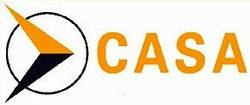Thu, Dec 04, 2003
AWB 27-4 Issue 1, 5 December 2003: Cessna 172, 180 and 185
Primary Flight Control Yoke Inspection
 Effectivity: Cessna
Aircraft Company and Reims Aviation (Cessna) 172, 180, and 185
series aircraft as listed in the current revision of Cessna Service
Bulletin SEB01-3.
Effectivity: Cessna
Aircraft Company and Reims Aviation (Cessna) 172, 180, and 185
series aircraft as listed in the current revision of Cessna Service
Bulletin SEB01-3.
Purpose: To alert operators and maintainers to
the potential failure of the welded steel tube yoke assembly, which
can result in loss of primary pitch control of the aircraft, and to
strongly recommend compliance with Cessna Service Bulletin SEB01-3.
This SB describes an inspection procedure to detect corrosion, and
determine the serviceability of a yoke that has suffered corrosion
pitting.
 Background: CASA and the
FAA have received defect reports describing extensive internal
corrosion initiated by moisture collecting inside the lower section
of the welded tubular structure. Some control yokes have suffered
structural failure due to corrosion in this zone.
Background: CASA and the
FAA have received defect reports describing extensive internal
corrosion initiated by moisture collecting inside the lower section
of the welded tubular structure. Some control yokes have suffered
structural failure due to corrosion in this zone.
The design of the control yoke in the nominated aircraft did not
have any provision to drain moisture from the lower section of the
yoke. This allowed moisture to collect inside the vertical tube of
the assembly, and initiate corrosion. In some cases the corrosion
caused a significant reduction of wall thickness of the yoke, and
resulted in failure of the lower elevator control lug.
Cessna Aircraft Company has issued instructions for an insitu
inspection of the control yoke, which requires an ultrasonic
inspection of the lower section of the yoke assembly. Yokes that
are corroded beyond the limits prescribed in SEB01-3 should be
replaced.
 In addition to this, CASA has
received a defect report describing internal corrosion deposits
outside the nominated area indicated in the Cessna SB, being
significantly higher up the vertical tube of the yoke than the
shaded area shown in Figure 1 of SEB01-3.
In addition to this, CASA has
received a defect report describing internal corrosion deposits
outside the nominated area indicated in the Cessna SB, being
significantly higher up the vertical tube of the yoke than the
shaded area shown in Figure 1 of SEB01-3.
Recommendation: CASA strongly recommends
operators and maintainers carry out the requirements of the current
revision of Cessna Service Bulletin SEB01-3, extending the zone of
eddy current inspection to match the extent of surface corrosion
detected, and incorporate the annual inspection requirements of
SEB01-3 into the aircraft maintenance program.
More News
Outboard Section Of The Right Wing And The Right Flap Separated In Flight And The Airplane Impacted A Farm Field Analysis: The pilot was approaching his destination airport under i>[...]
Final Approach Fix The fix from which the final approach (IFR) to an airport is executed and which identifies the beginning of the final approach segment. It is designated on Gover>[...]
"Our choice of when to respond, how to respond and on which targets to respond is a consideration that we make every time... Netanyahu also noted that anyone attacking Israel &ldqu>[...]
Estimated (EST) When used in NOTAMs “EST” is a contraction that is used by the issuing authority only when the condition is expected to return to service prior to the e>[...]
Aero Linx: Coalition of Airline Pilots Associations (CAPA) The Coalition of Airline Pilots Associations (CAPA) is the world’s largest pilot trade association representing ove>[...]
 NTSB Final Report: Cessna 177B
NTSB Final Report: Cessna 177B ANN's Daily Aero-Term (05.08.25): Final Approach Fix
ANN's Daily Aero-Term (05.08.25): Final Approach Fix Aero-News: Quote of the Day (05.08.25)
Aero-News: Quote of the Day (05.08.25) ANN's Daily Aero-Term (05.09.25): Estimated (EST)
ANN's Daily Aero-Term (05.09.25): Estimated (EST) ANN's Daily Aero-Linx (05.09.25)
ANN's Daily Aero-Linx (05.09.25)





